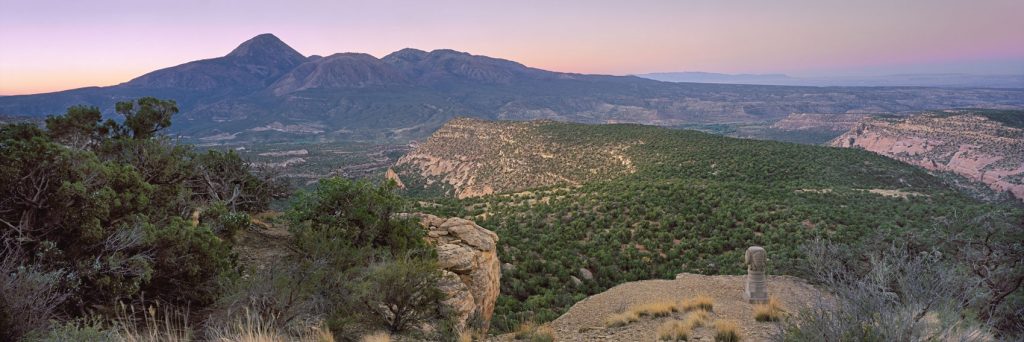You’re so deep in the Colorado wilderness that for days the only human face you’ve seen is your own, in the reflection of a mountain stream or a tin canteen. You turn a bend, and where are you? In the rubble of an ancient Buddhist shrine?
This moment of shock, of disorientation, is precisely what the artist Peter Hassen wishes to induce. In the dark of night, he hauls massive monuments onto public lands, in remote areas of the American wilderness. The monuments are cast-stone replicas of sacred sculptures: a Buddha head, a dancing Shiva, a hunched Egyptian falcon. It takes weeks of intensive labor for Hassen to mold and cast each one, and then there is a grueling overland trek, with 600 pounds of dead weight, a handcart, and only a small crew. Once the site is found and the monument erected, Hassen has to let it go, not knowing what the monument’s fate will be or whether he’ll ever see it again.
Recently, at the Sonoma Valley Museum of Art in northern California, I encountered a series of giant, panoramic photographs of Hassen’s “Landscape Interventions,” as he calls them. The photographs are all that remain to him of each undertaking, and I found them both visually stunning and conceptually riveting. No matter how radically out of place—a giant bodhisattva leaning under quaking yellow aspen or a black Nevada sky—to me each sculpture looked as though it had been holding its ground for centuries. Though its presence was actually just as transgressive as graffiti sprayed on a post office wall, it looked as though it belonged there.
But the friend who’d come to see the show with me was having none of it. Steve is both a painter and a passionate backpacker, and while I was making little sounds of amazement, he was looking more and more irritated. “Why can’t he just leave the wilderness alone?” he exploded. “I hate it when humans have to leave their mark on nature. It’s like animals marking their territory. You know how people leave those little piles of rocks along trails? Well, when I come upon them, I kick them.”
I knew that my friend had a misanthropic streak, but to kick one of those carefully balanced little towers of stones—that seemed positively mean to me, and I told him so.
“Just leave the wilderness alone,” he said again. But where did that idea come from? Human beings have been leaving their marks on the wilderness for thousands of years. Just think of petroglyphs, cave paintings, Stonehenge. It’s like animals marking their territory. Precisely. There’s actually nothing more natural for the human animal than to make an artifact, to alter the environment in a way that says, “Look! I was here!” Where did we get the idea of nature and human culture as two radically different spheres?
Later, when I met Peter Hassen, I understood that he’s quite happy to induce this line of questioning in anyone who comes upon his work, whether in an art museum or a tract of wilderness. After finishing his B.F.A. in Boulder, Colorado, Hassen spent a year traveling around the world. Even in the most remote areas of jungle, forest, mountain, or desert, he would come upon signs of ancient human presence. “In most of the world, you can’t throw a stone without grazing some sacred monument,” he told me. “It’s only we Americans who have this notion of an untouched frontier. And it gives us a kind of hubris. We don’t grasp that we’re just the tip of a giant iceberg of human culture.”
Hassen believes that when we get even a glimpse of our true place along this vast continuum, it can be transformative. In the shock of coming upon a dancing Shiva or a leaning bodhisattva in the middle of nowhere, we can actually discover a more profound sense of belonging. This idea also informs his more recent “Discovery Series.” Traveling up and down the coast of California, from the Mexican to the Oregon borders, he has buried 50 Buddha heads, three feet deep in the sand. They are buried at the tide-line, so there will likely be a gradual emergence of the heads.
Some people, I’m sure, would consider this project a grandiose form of littering. But if I were walking along a pristine expanse of beach, I’d be awed to discover the Buddha’s eye, nose, mouth, ear emerging from the glistening sand. Maybe, for a second, I’d be transported back to the most ancient times, when artists refrained from fully depicting the Buddha. To indicate the luminous vastness of awakened mind, they would give only the merest sign, the outline of his footprint, as if traced in sand, or the pattern of a wave made by three rippling lines. And who knows? As I’d bend down to wrest the figure from its ground, perhaps within the crashing of the waves I’d hear these human sounds: Form is emptiness. Emptiness is form.
Thank you for subscribing to Tricycle! As a nonprofit, we depend on readers like you to keep Buddhist teachings and practices widely available.
